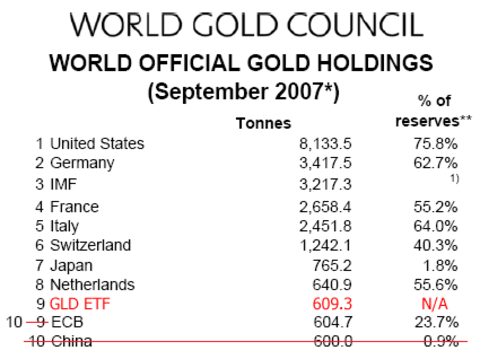GLD No Longer Among Top 10 Biggest ETFs
Post on: 30 Май, 2015 No Comment

SPDR Gold Shares (GLD | A-100). the world’s biggest gold ETF, is no longer among the world’s 10 biggest ETFs, as the yellow metal continues to lose its luster amid ongoing signs of economic recovery in the U.S. GLD’s fall from the Top 10 is an event worth noting considering GLD was the biggest ETF in the world for two trading days in August 2011 in the aftermath of S&P’s historic downgrade of U.S. debt.
GLD became the biggest ETF on Aug. 21, and its assets maxed out on Aug. 22 at $77.5 billion. Then, on Sept. 6, 2011, gold prices reached a cycle high of $1,921. But in the rearview mirror, the gold-inflected anxiety about the U.S. in the summer of 2011 was unfounded. Hindsight is 20-20, but shrewd Buffett-esque investors could have taken GLD’s rise to the top of the ETF world as a sign things had gone too far.
Fast-forward three-plus years, and GLD ended 2014 as the 11 th -biggest ETF, with $27.3 billion in assets, right behind the Vanguard S&P 500 ETF (VOO | A-97). which ended last year with $27.5 billion, according to data compiled by ETF.com. GLD’s outflows of $3.3 billion in 2014 followed outflows of more than $25 billion in 2013—the year that the 11-year gold rally really began to fall apart.
Also, the price of gold has tumbled in the past few years by more than a third to around $1,200 an ounce from that all-time high in September 2001, also pulling assets in GLD lower.
In the end, it’s impossible to divorce the fading luster of gold from the rising fortunes of the dollar, which is now at a nine-year high against the euro. U.S. growth, with a few fits and starts, has held up since the “Great Recession,” and the job market has slowly improved. Crucially, as the Federal Reserve has continued to inch toward tightening credit, flows into dollar-denominated assets have picked up.
The World’s 10 Biggest ETFs At the End Of 2014
Parsing Gold’s Pullback
That said, gold prices aren’t exactly falling out of bed these days. Yes, they tumbled 29 percent in 2013 after then-Fed Chairman Ben Bernanke said the Fed’s “quantitative easing” bond buying aimed at keeping borrowing costs lower would start to end by the end of 2013.
By the end of 2014, gold prices only fell 1.5 percent. Those modest declines are a clear reflection of the head winds in other parts of the global economy. To put a finer point on these regional distinctions, gold’s 1.5 percent decline is relevant to dollar-based investors.
But those investors who purchased gold in euro or in yen watched their holdings in the yellow metal rise last year by 12 percent and 11.5 percent, respectively. Those gains are entirely due to weakness of those currencies stemming from persistent macroeconomic challenges and deflationary pressures in those economies. Also, new concern that Greece may have to leave the eurozone is also lifting gold prices.
While Japanese or, say, German, investors could readily buy gold in their respective currencies, U.S. investors can do it without foreign brokerage accounts through some ETFs that are on the market. The two funds—the AdvisorShares Gartman Gold/Yen ETF (GYEN | D-31) and the AdvisorShares Gartman Gold/Euro ETF (GEUR | D-33) —each have less than $10 million in assets.
Readers should note that both funds launched in February 2014, which explains part of the difference in returns between the chart below and the full-year data above. GLD, the loser of the three, is in red below.














